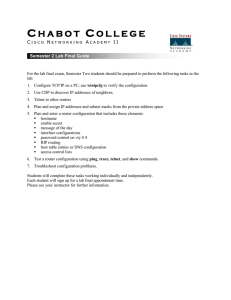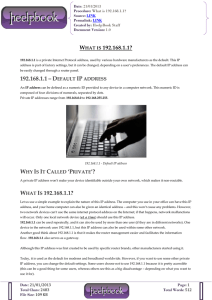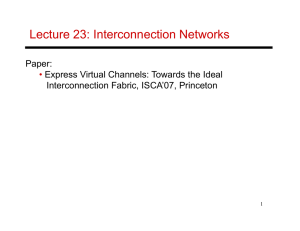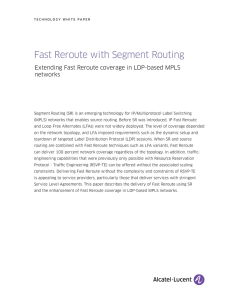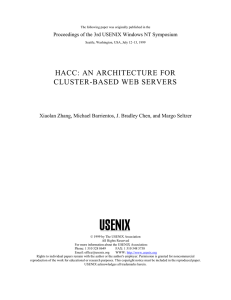Management for IP-based Applications Mike Fisher BTexaCT Research
advertisement
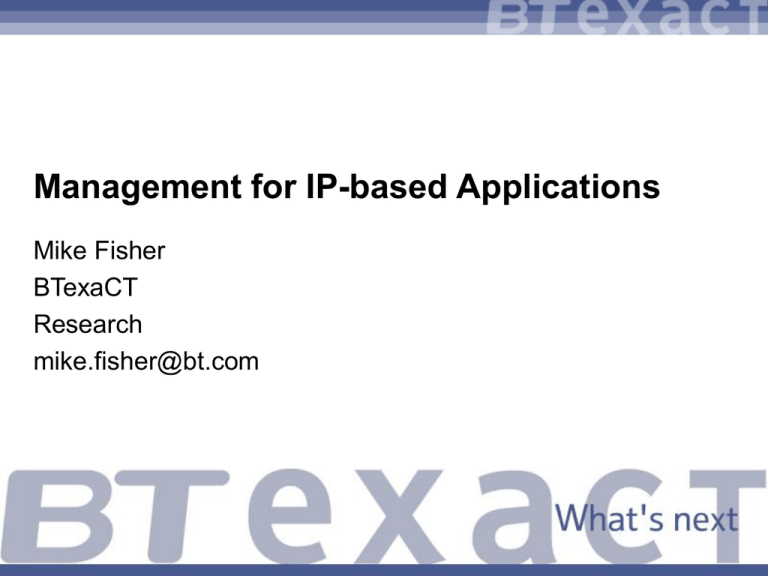
Management for IP-based Applications Mike Fisher BTexaCT Research mike.fisher@bt.com Introduction • • • • Future networks and applications Active Networks Management Problems Active Management Evolution of the Internet • Demand for new applications/ customisation • Infrastructure can’t keep pace with application explosion • Multimedia – need for QoS, correlated flows, multipoint • Control of end-to-end application performance • Flexible infrastructure and adaptable management Multi-owner Network Administrator 3 Administrator 2 Public Network Policies (SLAs) Administrator 1 User ? Programmable Networks • computation in the network, not just routing • users can introduce programs – delegate control and responsibility – improved resilience to change – … increased risks from sharing control Active Network Technology • Dynamically update software on network element to change node behaviour • Users/Operators/Value-Added Service Providers create new services to run on active nodes • Active nodes include routers, proxies, firewalls etc • Two categories: – capsule-based approach - packets may contain both data and active code to be executed at node – discrete approach - active code downloaded out-of-band from code libraries/caches Locating Active Programmability Core network devices Host Border devices Edge devices P1520 reference model Architectural Requirements • Divide programmability • Active Router – OSI layer-3 functions – embedded scripts or programs, from trusted sources – low memory and computational power • Active Server – application layer active networking – many specialised nodes • transcoding node requires efficient maths operations • node supporting active caching require high-performance I/O Active Architecture transfirewall coder Active Server smart cache active email Active Server PC Active Router Active Router PC Active Application Code Server Normal Router Active Virtual Network virtual space normal link active server router active router virtual network link client Management problems • • • • • • High percentage of IP VPN costs New features (e.g. multicast, QoS) do not get added Changing MIBs is extremely difficult Centralised control model limits scaling Inefficient information flows Manual intervention • Made worse by demands of new applications A solution? • • • • • • Minimise operator intervention Enable flexible addition of features Support diverse information models Use high-level policy-based interfaces Distribute and delegate Give responsibility to customers • Active Management System Active Management • No central point of control • Autonomous decision making based on policies and local knowledge • Dynamically introduce – – – – new active server types new policy sets new mechanisms for policy storage and retrieval new algorithms for policy decisions and enforcement Active Management • Hierarchical • Autonomous Admins Management agent Autonomous controller Users EEP Proxylets Summary • Flexibility in services demands an active approach • Two levels of programmability – active server – active router • Approach to management – programmable infrastructure – delegate application management • Policy-based active management required




